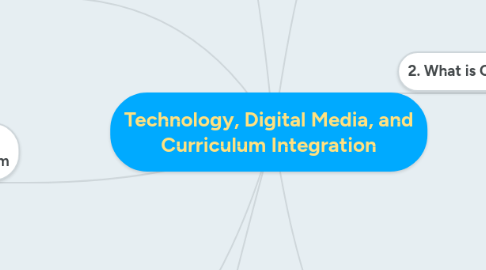
1. 4. Integrating Technology in the Curriculum
1.1. When a teacher integrates technology into the curriculum, he/she has the opportunity to address different learning styles. When teaching a lesson, a teacher can display pictures/videos/interactive activities on the board and have students participate and learn. This provides students the opportunity to see/hear/discuss the lesson rather than just hearing a lecture.
2. 5. Technology Integration and the Learning Process
2.1. The Learning Process
2.1.1. Authentic learning: instructional activities that help students connect to real-life experiences
2.1.2. Participatory/Secondary Learning: when students research ideas, analyze and reflect on their findings
2.1.3. Anchored Instruction: when students take prior knowledge and apply it to what they are learnin/experiencing
2.2. Technology and the Learning Process:
2.2.1. In a world with so much technology and media, it is now easier to connect and discover new things. In the classroom, students, no matter their status and background, can access all kinds of information via the Internet and media resources. Students can now see virtual aspects of what is being taught, and this allows for a greater learning process.
3. 7. Instructional Methods
3.1. When planning a lesson, a teacher must follow a model (lesson plan) to make sure everything is laid out in an appropriate manner. The ASSURE model focuses on these areas: analyze the learner, state objectives, select methods, media and materials, utilize methods/media/materials, require learner participation, and evaluate and revise. Through this process the teacher will understand his/her students, plan according to their needs, align with standard and state objectives, assess and decide the next step. This is very crucial for a successful classroom.
4. 8. Creating and Integrating Digital Media Presentation
4.1. When teaching a lesson, a teacher can integrate digital media in different ways. He/she can use data projectors or interactive whiteboards. The data projectors is when a teacher displays information on the board for the students to view. Interactive white boards is when a teacher displays information on the board, but he/she can change things, draw on it, play videos and much more. Students, if allowed, can come up and use the interactive white board as well. Some examples of interactive white boards are SMART Boards, SMART Table and an ActivBoard.
5. 6. Planning for Technology Integration in the Classroom
5.1. In every school and classroom, the amount of computers limits the access students have to the Internet or other forms of learning. Whether a teacher has one computer or one for every student, he/she must plan accordingly to what type of learning will take place. Will it be whole group, small groups or individual learning?
6. 1.What is Digital Media?
6.1. Digital media is when all of the elements of multimedia is used, but it is in digital format. Multimedia is defined as "more than one media," such as recordings, videos, etc.
6.1.1. Text: characters used to create words, sentences and paragraphs
6.1.2. Graphic: non-text. A graphic is a picture that does not move that is giving information.
6.1.3. Animation: a graphic with movement
6.1.4. Audio: music, speech, or any other sound that describes a concept
6.1.5. Video: visual frames that provides full motion

